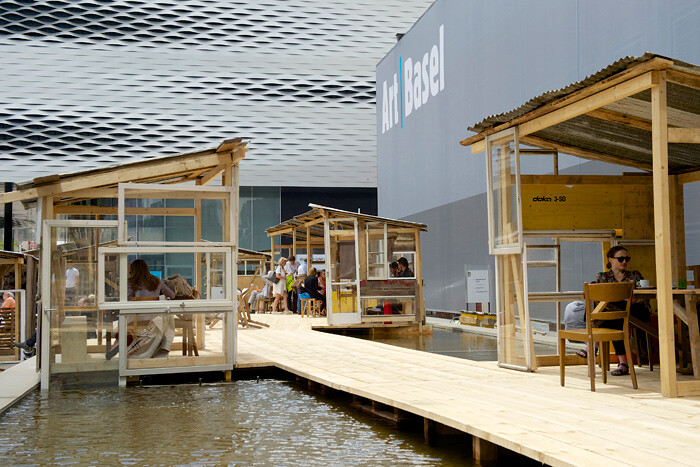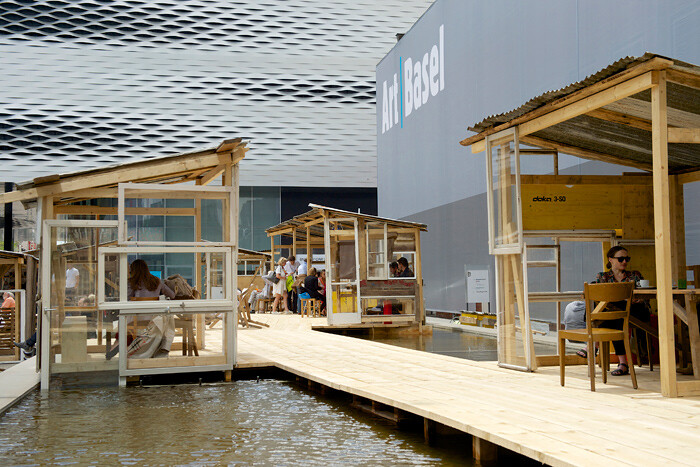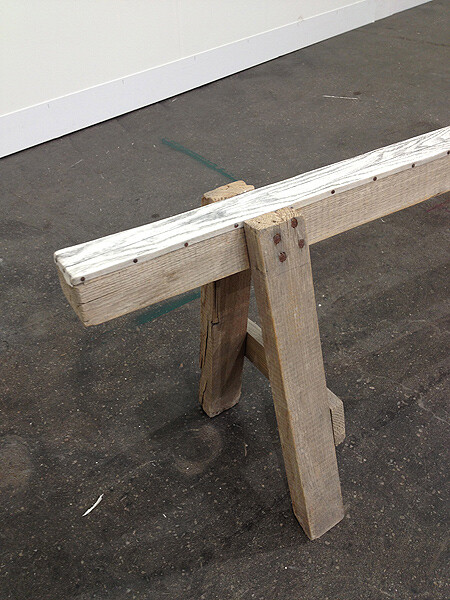Art Basel is vast. It always is. But this year it’s larger than ever, with the site expanded by some 20%.1 Consequently, Design Basel is now brought into the fold on Messeplatz and the Swiss Art Awards are around the corner but in an improved space. The Basel experience has become more streamlined, and the rudimentary shelters created by Tadashi Kawamata outside the main entrance, reusing pallets and other waste, provide intimate meeting and eating spaces. But why, oh why, did it have to be called Favela Café (2013), in this richest of cities at this temple of conspicuous consumption?
Inside, I decided to hit the Unlimited section first, as one is wont to do, and where the fair feels more curated, and it is—with really large works on display, whereas the Statements section for younger galleries was trimmed down, and there was a new Feature section of truly “curated” stands. (Are there other galleries who put their selections together in the dark?) Following hot on the heels of the Frieze New York, Art Basel’s first Hong Kong fair, and the Venice Biennale to boot, the strain is showing on a lot of gallerists. Many are capitalizing on their artists’ presence in Venice by bringing their works to Basel (Alice Channer, Jeremy Deller, or Hans Josephsohn, being cases in point), which is clear bandwagon-ing, but does no harm in cementing impressions gleaned in Italy and gaining a broader understanding of these artists’ practices.
In Statements, there were two galleries competing for the prize for most minimal display: at Galerie Hubert Winter, sections of wire embedded under a thin layer of the booth’s walls were given an electric charge to create the scorch marks of Judith Fegerl’s cauter (2012); and at Chert two iPhones mounted side by side are playing films of a sunset and sunrise, The Distance of a Day (2013) by David Horvitz, which is actually the distance between the artist and his mother, who was instructed to film the setting sun in California while Horvitz filmed the sun’s “other side” somewhere in the Maldives. But Hu Xiaoyuan’s work in Beijing Commune’s stand trumped them both in subtlety and effect; otherwise easy to pass by, No Fruit at the Root (2012) consisted of some rather fine duplication not to be missed. Taken collectively, the section lacks the sucker punches of previous years, like when Petrit Halilaj filled Chert’s stand with sixty tons of earth from his family’s erstwhile home in Kosovo (Kostërrc, 2011). But there is Jessica Jackson Hutchins, also fresh from the Arsenale in Venice, whose four large ceramic, plaster, and other mixed media sculptures were presented in Laurel Gitlen’s stand. Without the space of the Venetian venue, these are crowded together, like maiden aunts wedged into their chairs, their makeup just a shade too lurid, but fun guests nonetheless.
The Feature section is cut off from Statements by the main body of the fair, which is to these galleries’ advantage. What they lack in daylight they are likely to make up for in exposure to the bigger collectors. At one end of the section Herald St from London had a live tableau entitled Marie Antoinette and Robespierre engage in an irritable post-coital conversation (2013) by Pablo Bronstein. A pair of wigged and powdered actors sit up in two beds, back-to-back, reading books studiously, while a bust of Rousseau observes the scene. If the title situates the work quite specifically, the fabrics, costumes, and furniture are a historical mash up—more faux than true historic recreation. As the pair never met, let alone had a liaison or an argument, their meeting is as artificial as their leisure. Another highlight, an earthy counterpoint to Bronstein’s baroque fancy, was freymond-guth’s presentation of latex “skinnings” of spaces by Swiss artist Heidi Bucher (who died in 1993), including the undated Mental Institution in Kreuzlingen-Schloss Bellevue, for which she had taken the imprint of one of the institution’s windows, its shutters, and shingled exterior. The yellowed medium is at once transparent, fleshy, and suffocating: a mix of claustrophobia and defensiveness, as the shingle patterns become sharp scales.
In the main fair, business as usual included discoveries like Nathalie Djurberg’s seat/sculptures at Gío Marconi, designed for watching the Swedish artist’s creepy animations, unexpectedly menacing (i.e., a boiled egg, the white stained black, its edges sharp but yielding to the touch). At Galerie Nathalie Obadia were works from Turkish artist Sarkis that complement his ongoing revival, thanks in part to the Fondazione Prada’s remaking of the 1969 exhibition “When Attitudes Become Form” in Venice. His Scène en cuivre (2012) pins a shaman’s cloak, replete with small totemic brooches, to the wall using a t-bar made from copper pipes. At the meeting of contradictory meanings, this could be a scarecrow, a union banner, or a suicide vest. And at Annet Gelink Gallery is a junky jet engine—an untitled work from Roger Hiorns—displayed together with the documentation of its “activation” by the temporary placement of both a youth and a symbolic fire upon it before the fair’s opening.
But this is not to forget the four hours I spent at the opening of Unlimited amongst a crowd of cartoonish platform (well-) heeled visitors. This section always emulates a museum installation and succeeds in looking like a museum in the virtual Second Life, and institutions are most likely the target audience. In this virtual vein, Ai Wei Wei’s Fairytale 2007, Ladies Dormitory (2007), one of the structures in which the 1001 Chinese citizens the artist brought to Kassel for Documenta 12 were accommodated, here looks more like a Disneyland prop than a space people could live in for weeks. Huang Yong Ping’s Abbottabad (2012) is a terracotta model of the compound in Pakistan where Osama bin Laden was found and killed. This version has become a garden for plants that grow thickly from the buildings, suggesting new growth on the site of this bloody history, but the impression remains of a gated compound, an artificial site cut off from its environment. The unreal trend reached its pinnacle with Thomas Demand’s Pacific Sun (2012), a film of a paper set, reconstructing security camera footage of a café on a ship on high seas, the contents flung to and fro. Demand’s model is filled with blank objects that suggest neutral timelessness, though the model electronic payment machine by the till belies this.
After this I was thirsting for reality, and I was delighted by two projects hiding in plain sight. Matt Connors’s Demonstration (red and blue) (2013) repeats the same simple trick twice. A standard section of wall, six meters tall—one facet painted red in one iteration, in the other blue—is joined by a slightly thinner, freestanding white wall section, leaning against the first. It’s not often that a six-meter tall sculpture can be overlooked, but at Art Basel it’s possible. Around about the time I first spotted Connors’s “hidden” walls, a man ran past me. Dressed in casual shorts, he looked like a technician in an installation emergency. He ran past me again later, in the same direction, and at least once more during my own personal (slowmo) Unlimited marathon, until I figured out that I was witnessing Martin Creed’s Work No. 570 (2006). In theory there are several runners, but I only saw this one, and he and I got ever wearier as the day went on.
Virtuality gave way to theatricality; Theaster Gates’s installation BNKUDRWTR (2013) was given a menacing touch thanks to a guard in a peasant-style uniform patrolling it, and the hall ended with Piotr Uklański’s Untitled (Open Wide) (2012), a complex textile awning making a giant open throat, from which actors might be regurgitated to meet the audience. Jonah Freeman and Justin Lowe’s Artichoke Underground (2012/13) was also garnering lots of attention, an Arte Povera-style heap of clothes forming an entrance to a disturbing warren of retail or office-style spaces where goods formed from rice seemed to be for sale.
In all there were some eighty works in this section, many too many to mention, but my time there ended with a reflection on reality, and just how I wanted to experience it in an art fair. I was very happy to see Pierre Huyghe’s Untilled Film (2013), which documents his installation in Karlsaue Park in Kassel for last summer’s Documenta. This didn’t attempt to clarify the work, but was a new, complex film in which nighttime impressions of the stone sculpture, the scavenging dog with its scarlet paw, and the bees and their hive are bound together by an impressive ambient soundtrack in which ants sound like marching armies and insect wings like drones. On the subject of drones, Johan Grimonprez’s film The Shadow World (2013) is a documentary exposé of the weapons trade. A former war correspondent and a former South Africa Special Forces soldier and later arms dealer both reveal the stranglehold of the trade on global politics and global wars. Shocking images and shocking testimony left me reeling and wondering what I, and the work, were doing in this art context. Was the rest all bread, circuses, and Kanye West concerts? It was a difficult circle to square, though seeing Kader Attia’s slide installation The Repair (2012) helped reconnect art and life. Attia’s images contrast repairs of African ceramics with the surgical “repairs” made to disfigured WWI soldiers. The work is without a doubt critical and thoughtful, but at that moment, I was most glad that it somehow made the cultural realm an active battleground once again.
The expansion of the fairground was actually driven by the even more valuable Baselworld fair for jewellery and watches, which takes place in the spring.















